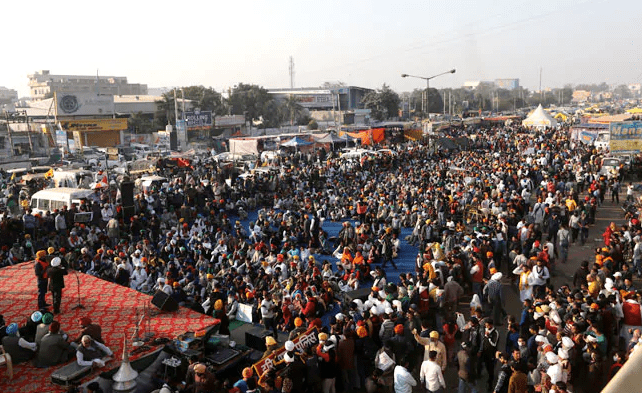A rare fungal infection disease is spreading in India at a time when the cumulative number of confirmed cases of COVID-19 in India exceeds 10 million. According to India, dozens of COVID-19 patients in India have recently suffered from severe mucormycosis fungus, many of whom have lost their eyesight or died as a result. The mortality rate is as high as 50%.
According to India’s Business Insider on the 20th, 24 people have been infected with hairy fungi at Max Specialist Hospital in New Delhi. All of these cases were COVID-19 patients, 20 of whom had lost their eyesight, said Sanjay Sachdeva, a physician at the hospital.
In the past month, many Indian hospitals have exposed such incidents. Mrs. Hardinger Hospital in New Delhi also reported five cases of fungal infection, including three cases of COVID-19. In a hospital in Ahmedabad, India, five patients were infected with the novel coronavirus, including two deaths and two losing their eyesight.
The Gangalam Hospital in New Delhi, which was the earliest hospital to report cases of infection, reported 12 patients with COVID-19 infection in the middle of this month. The Indian Express revealed on the 15th that the hospital performed surgery on 10 infected people to remove the infected tissue, five of whom died.
Manish Munjal, an ear, nose and throat surgeon at Gangalam Hospital, said that such fungi are usually inhaled from the nose and then transmitted to the eyes and brain. If not detected and treated in time, more than 50% of the patients may die within a few days.
According to the introduction, the fungus of hairy mildew usually enters the human body from the nose and scraping skin tissue. Nasal congestion, enlarged eyes, prominent eyeballs, red and swollen cheeks, and black dry scabs on the nose are early symptoms of infection. When the infection spreads to the brain, similar seizures or convulsions may also occur.

Screenshots of print media reports
However, why does such fungal infections continue to spread among the population of patients with COVID-19? Dr. Manjaar explained that the novel coronavirus has weakened patients’ immunity, making them more vulnerable to fungi. But the doctor was shocked by the recent occurrence of cases in India. He said that the incidence of hairy mildew disease induced by the novel coronavirus is high and the mortality rate is high.
“In the past 18 years, I have seen more than 20 cases of hairy mildew disease,” said evang Gupta, an ear, nose and throat doctor at the Civil Hospital in Ahmedabad, India, told the Times of India. But in the past nine months, we have seen 46 such incidents (including 9 deaths). Most patients recover from COVID-19 and their immunity declines.”
Due to the surge in cases of hairy mildew disease, the government of Gujarat, India, issued an alert on the 22nd that the overall mortality rate of hairy mildew disease fungal infections is 50%, which generally attacks people with weak immune systems and diseases. However, Gujarat pointed out that such infections do not spread from person to person, and advised people to prevent infection by wearing masks.
India’s confirmed cases exceeded 10 million, and the economy suffered a heavy setback.
At present, India’s cumulative number of confirmed cases of COVID-19 has exceeded 10 million, becoming the second country after the United States to have more than 10 million confirmed cases. According to the Indian Express, as of 9:00 a.m. on the 24th, India has reported 24,712 new confirmed cases in the past 24 hours.
On the one hand, there is a severe epidemic prevention situation, and on the other hand, there is an unstarted COVID-19 vaccination campaign.
India’s Business Standard revealed that India may start vaccination in January next year. Recently, Indian pharmaceutical company Bharat Biotechnology Co., Ltd., American company Pfizer, British company AstraZeneca and other companies have submitted their respective emergency authorization applications for the use of the coronavirus vaccine to the Indian government.
However, the distribution and vaccination links also face challenges. Analysts pointed out that the storage and transportation conditions of many candidate coronavirus vaccines are harsh and require the coordination of a strong industrial chain, but India has bottlenecks in the storage and transportation of vaccines.
The epidemic, which has lasted for several months, has hit India’s economy hard. India’s gross domestic product (GDP) fell 23.9% in the first quarter and fell 7.5% again in the second quarter. The country’s tourism, retail and catering industries continue to be hit.
The New York Times reported in November that according to the data of India’s Economic Monitoring Center, the number of unemployed in the country exceeded 100 million at a time when the nationwide epidemic lockdown was implemented. India’s unemployment remains as the lockdown is slowly opening up to 6 million.
Recently, large-scale peasant protests in India have hindered the prevention and control of the epidemic and economic recovery in the country. Dissatisfied with the Modi government’s new agricultural policy and questioning the new policy will lead food giants to manipulate the food market farmers flocking to the streets for days to protest.
Hardeep Singh Puri, Minister of the Indian Civil Aviation Alliance, said on the 22nd that the peasant protests had damaged the country’s agriculture and related industries.



